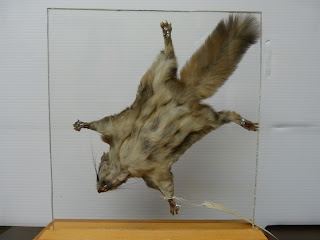Skinning Squirrels for Science
Cold winter nights call for wrapping up in soft blankets, retiring to a good book, or even warming up while skiing through a snowy wonderland. Rather than engage in such pleasant pastimes last weekend, I instead pulled out the remains of two salvaged squirrels from a freezer and began dissecting them. How's that for a comforting evening?
 |
| Mid-preparation, two flying squirrel study skins were brought out to show the Museum's docent. |
It's always on my mind that the remains of animals I handle were once living creatures. But the process of specimen preparation is far from gruesome or distasteful. Instead, I find it to be a rewarding experience that adds meaning to an animal's life even in death. It provides me with a unique opportunity to study anatomy, improve my artistic and tactile skills, and allows me observe the bizarre wonders of nature.
Flying squirrels have some interesting anatomy to study during specimen preparation--like the hallmark flaps of skin which allow them to glide. I instinctively felt for the complex membrane, called a patagium, as I spread one squirrel's fore- and hind feet to prepare for the first incision. Despite how thin it is, a patagium functions with the use of various muscle groups and fibers. I quietly imagined how important this feature must have been to the squirrel that was lifeless in front of me, then continued on.
 |
| Patagia are membranes of skin between limbs of flying or gliding mammals. They're best observed when the animal is in action. |
Moments after spreading the patagia, I began working internally and noticed another adaptation. With a dainty leg between the fingers of my left hand, I used my right to remove muscle tissue from bone. I felt between my fingers what seemed to be a thin, misplaced bone. Even though I had completed a taxidermy preparation of a flying squirrel months ago, I had been unaware of what I now know was styliform cartilage. This cartilage spurs off at each wrist and helps to extend the squirrel's patagia. It's an important feature that I nearly overlooked. Perhaps such a discovery warrants me working on an animal even slower than I already do.
 |
| Although flying squirrels cannot truly fly, this Museum taxidermy specimen helps to demonstrate adaptations that allow flying squirrels to glide. |
Supper time passed without me developing much of an appetite, so I continued to salvage parts from the two skinned squirrels. I removed a skull for cleaning and admired the characteristically large eyes. While there's little charm to a skinned head, I was still impressed that such large eyes were in such a small skull. This is part of how flying squirrels have evolved for a nocturnal existence. The scale of a flying squirrel's eyes is in order to collect more light, but also limits the squirrel's depth perception. Adaptations like this or the patagia are simple to observe. Still, I knew that the flying squirrels had an even more exciting adaptation which could only be experienced when placed under a UV light bulb.
 |
| All tissues, including eyes, were removed from the above skull so that it could be preserved as a specimen. |
According to research recently published, North American flying squirrels fluoresce pink. More than anything, I wanted to witness the pink glow centralized on a squirrel's underside. After impatiently waiting a few days until cotton-stuffed skins had dried and all of the Museum staff had returned from our weekends, I was ready for another amazing observation. I ushered the group into the dark workroom and switched on a lamp that I had retrofitted with a UV bulb. There they were--two stomachs glowing pink! Although the function of this adaptation isn't yet understood, being able to witness it brought us all to a higher appreciation for flying squirrels.
 |
| This photo of a northern (top) and southern (bottom) flying squirrel under a UV light |
With so much to discover, I already look forward to my next specimen preparation. It may not be the most wholesome way to observe animals, but a Friday night spent learning about flying squirrels isn't too bad in my book.